The A34 British Comet Tank MK.1 Type B
This A34 British Comet tank can be found at the French Tank Museum in Saumur in the Loire Valley. The Museum is called Musée des Blindés ou Association des Amis du Musée des Blindés, 1043, route de Fontevraud, 49400 Saumur, France www.museedesblindes.fr . The word Blindés means armoured.
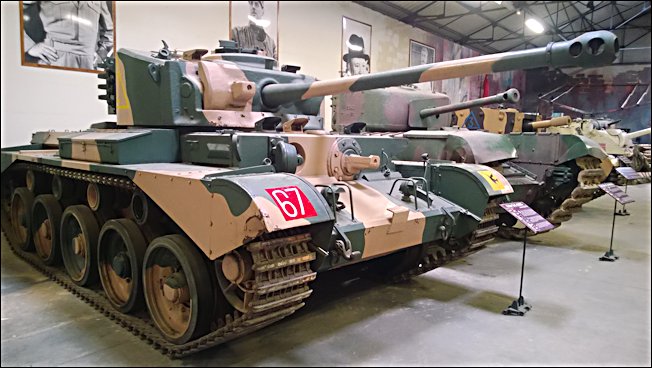
French Army 77mm Comet Tank at the French Tank Museum in Saumur
The Comet Tank proved to be a fast and reliable vehicle with an adequate road range. I spoke to a 1945 veteran Comet Tank commander at the last War and Peace Show in Folkestone Kent. When I asked him about his experience in this tank compared with the Cold War tanks he later went to command he said, 'The Comet was the last British tank to have a reliable engine that the crew could rely upon. It was a downgraded Spitfire engine called the Meteor. It only broke down if you gave it a good thrashing and did not look after the fluid levels. It gave you peace of mind. All the tanks from the Centurion, Chieftain and Challenger 1 and 2 have been plagued with unreliable tank engines because they moved to multi-fuel. They need to sort this out. Oh yes it had a blood good gun.'
Designed as an upgrade to the Cromwell tank the Comet incorporated a new improved Christie suspension and an enlarged turret. To avoid widening the hull a compact version of the versatile 77mm 17pdr gun was developed specifically for the A34 Comet. It had 100 mmm of armour at the front and a crew of five. It had a top speed of 50km/h (32mph). This tank saw active service from December 1944 in northern Europe with the British 11th Armoured Division.
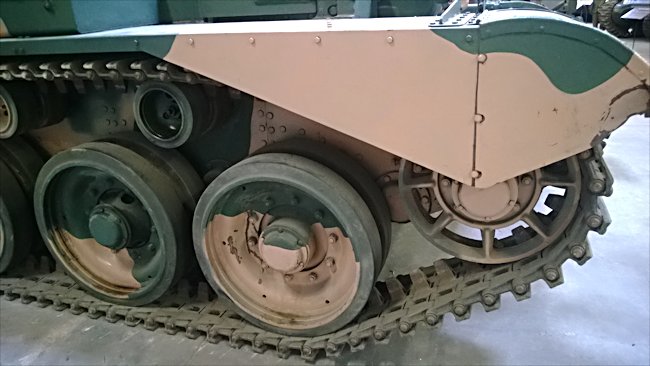
Front track wheels on a Comet Tank
The best British Tank of WW2 - A34 Comet
Up until the introduction of the British Cruiser class, A34 Comet tank there always seemed to be something wrong with earlier tank designs. This tank seemed to get everything right. It had good firepower, reliability, mobility and armour. It was a well-balanced tank. The 29th Armoured Brigade of the 11th Armoured Division in North West Europe were the first to be issued with the Comet. It was a shame that the tank was not around for D-day. It would have meant that the Allies could have taken on the German Panzer Divisions in a strong effective tank. It was introduced in December 1944 and although it was used in combat it did not take part in any major battles where it had a decisive effect. It arrived too late to speed up the end of the war.
When you initially inspect a Comet Tank it looks like the designers have taken a retrograde step backwards. They have not gone for the Russian T34 and German Panther tank style sloped frontal armour. But the armour is thick; 105mm.
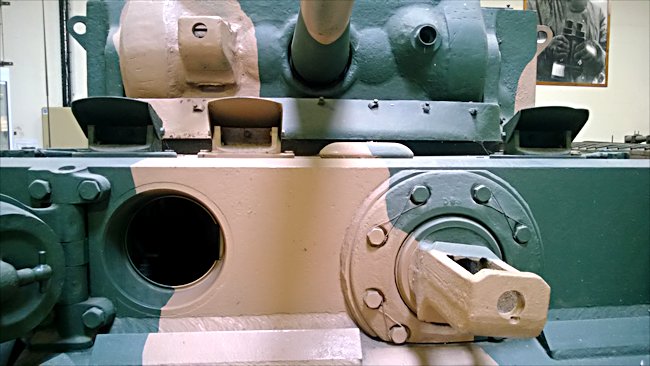
Drivers hatch and hull machine gun on A34 British Comet Tank, There is another machine gun in the turret.
The Driver has a plug, or a hatch, for use in road drives to help increase his vision. He does not have a hatch directly above he where he could have stuck his head out. The downside is that this hatch is a weak point in the armour but if you look closely the hatch is angled like a plug so if it gets a direct hit when closed down it is not going to push the visor into the drivers face.
The poor driver had a very small hatch to get into his seat. It was not above the seat but to the right. The periscope mounts were above the driving position. The tank driver had to be a contortionist and wriggle his body into position. If the tank was hit he would have a problem getting out quickly.
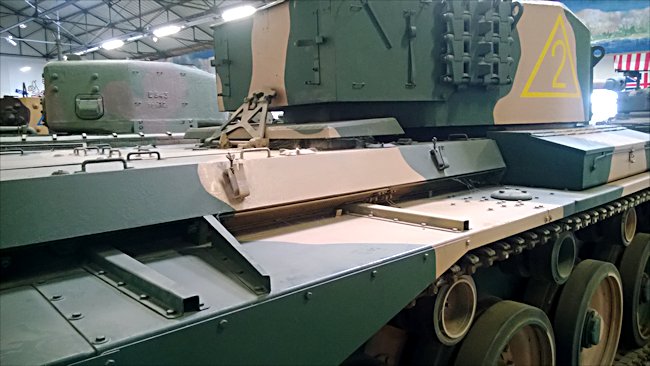
Side view of the engine compartment hatch and rear of the turret on a British Comet Tank
The 7.92mm Besa machinegun is located left side of the tank. Unusually the calliber of the ammunition for this gun was not used by any of the allies. It was used by the Germans. Crews would not be able to ask the Americans for bullets but they could use captured enemy ammunition.
This tank was designed for a ground war in Europe where they drive on the right unlike in Britain. The designers made this tank a right hand drive vehicle. The Comet Tank was the last British tank to use the traditional Christie suspension. It had been used on pre-war tanks like the A13. Tanks that followed the Comet used the Horstmann suspension. There are five pairs of roadwheels on each side of the tank. They all have their own independent spring and shock absorber behind the armour plating.
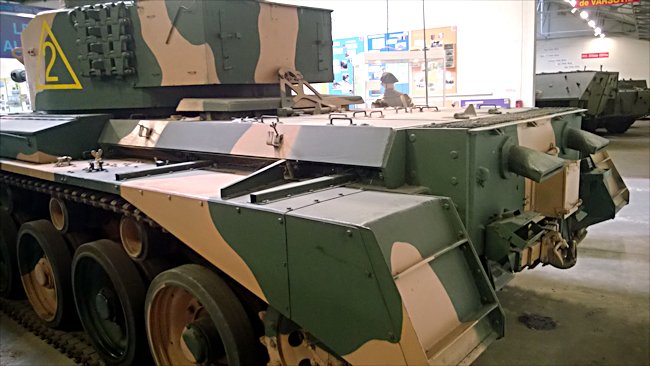
The double 'fishtail' exhaust pipes on a WW2 Comet Tank identify this Comet as a post war type B tank
This protects them but reduces the amount of room available in the crew compartment. Trying to repair a damaged or faulty spring or shock absorber was very problematic as the crew would be working in a very tight space. In fact the manual stated this repair could not be done in the field and the tank had to towed back to the depot.
There are no road driving rear tail lights at the back of the Comet but there is a maker light located on the top right. The box at the back is for a telephone so troops could talk to the tank commander. The rear engine compartment had four large metal hatches that could be removed for ease of access. The power unit was practically the same as that used on the Cromwell: a Rolls Royce Meteor V12 engine. The gearbox is a Merrit-Brown which was first used on the Churchill Tanks.
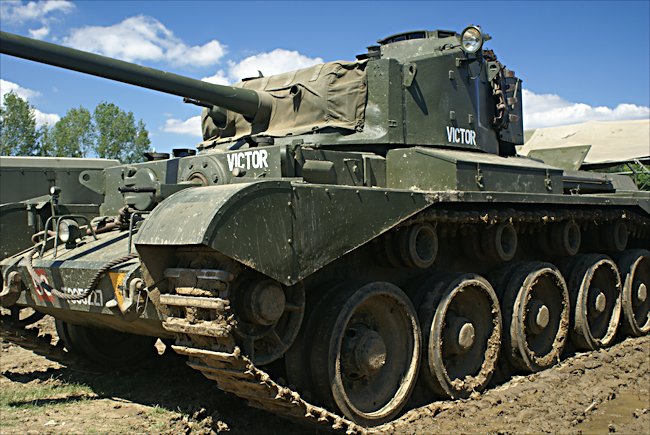
This privately owned British Comet Tank can be seen displayed at military vehicle events in England.
Have a look at the commanders open hatch position. There is a small metal structure that looks like the skeleton of toy house that has one roof taller that the other. This 'vane' was used by the commander as a gun sight to give directions to the gunner. The tank was armed with an Ordnance, Quick-Firing 77mm gun, more commonly known as the 17pdr.
The Comet was a good tank but only had a very short service life with the British Army because the Centurion was about to enter service after the end of World War Two and just in time for the Korean War. The Comets were sold off to friendly nations where they enjoyed many years of service.

A34 British Comet Tank called Victor
Where can I find other preserved A34 Comet Tanks?
- Bovington Tank Museum, England
- Hong Kong Museum of Coastal Defence, China
- Military Technical Museum Lešany, Czech Republic
- Deutsches Panzermuseum Munster, Germany
- Curragh Camp, Ireland
- Tank Museum in Kubinka, Russia
- Light Horse Regiment South Africa
- National Museum of Military History South Africa
- South African Armour Museum
- Special Services Battalion Museum South Africa
- Arsenalen, Sweden
- Cobbaton Combat Collection, England
- Wheatcroft Collection, England
- Military Vehicle Technology Foundation, USA
- Association de Sauvegarde du Patrimoine Historique Militaire. 1 Rue Georges Cuvier, La Watzenau, France
- Militärhistorischen Museum der Bundeswehr, Dresden, Germany
- Source - Pierre-Oliver Buan - http://the.shadock.free.fr/Surviving_Panzers.html
WW2 Comet Tank books

